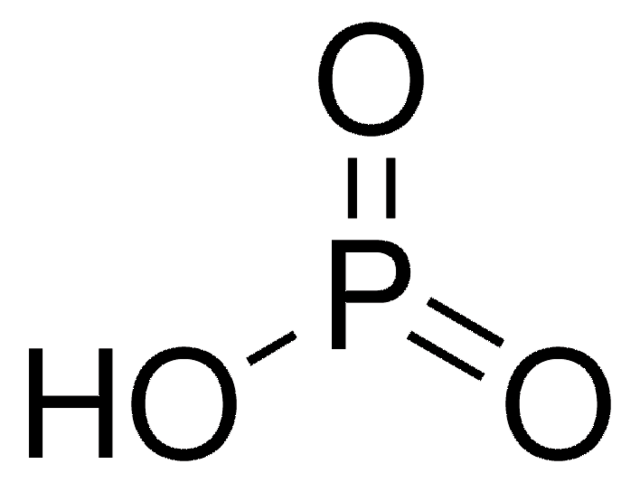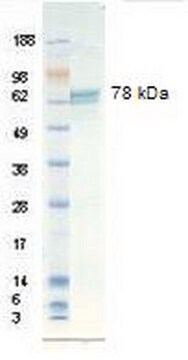239275
meta-Phosphorsäure
ACS reagent, chips, 33.5-36.5%
Synonym(e):
Metaphosphorsäure
About This Item
Empfohlene Produkte
Qualität
ACS reagent
Qualitätsniveau
Form
chips
Enthält
57.0-63.0% sodium phosphite as stabilizer
Konzentration
33.5-36.5%
Dichte
2 g/cm3
Anionenspuren
MnO4- reducers: ≤0.02%
chloride (Cl-): ≤0.001%
nitrate (NO3-): ≤0.001%
sulfate (SO42-): ≤0.005%
Kationenspuren
As: ≤1 ppm
Fe: ≤0.005%
heavy metals: ≤0.005% (by ICP)
SMILES String
OP(=O)=O
InChI
1S/HO3P/c1-4(2)3/h(H,1,2,3)
InChIKey
UEZVMMHDMIWARA-UHFFFAOYSA-N
Suchen Sie nach ähnlichen Produkten? Aufrufen Leitfaden zum Produktvergleich
Allgemeine Beschreibung
Anwendung
- Als Katalysator in Kombination mit InCl3 zur Synthese von 1,8-dioxooctahydroxanthen-Derivaten durch die Reaktion von cyclischen β-Diketonen und Aldehyden.
- Als Phosphat-Vorstufe zur Synthese von Antimonphosphat (SbPO4) durch Reaktion mit Antimonmetall bei hohen Temperaturen.
Signalwort
Danger
H-Sätze
Gefahreneinstufungen
Eye Dam. 1 - Skin Corr. 1
Lagerklassenschlüssel
8B - Non-combustible corrosive hazardous materials
WGK
WGK 3
Flammpunkt (°F)
Not applicable
Flammpunkt (°C)
Not applicable
Analysenzertifikate (COA)
Suchen Sie nach Analysenzertifikate (COA), indem Sie die Lot-/Chargennummer des Produkts eingeben. Lot- und Chargennummern sind auf dem Produktetikett hinter den Wörtern ‘Lot’ oder ‘Batch’ (Lot oder Charge) zu finden.
Besitzen Sie dieses Produkt bereits?
In der Dokumentenbibliothek finden Sie die Dokumentation zu den Produkten, die Sie kürzlich erworben haben.
Kunden haben sich ebenfalls angesehen
Unser Team von Wissenschaftlern verfügt über Erfahrung in allen Forschungsbereichen einschließlich Life Science, Materialwissenschaften, chemischer Synthese, Chromatographie, Analytik und vielen mehr..
Setzen Sie sich mit dem technischen Dienst in Verbindung.








